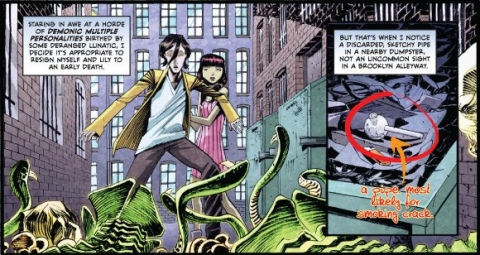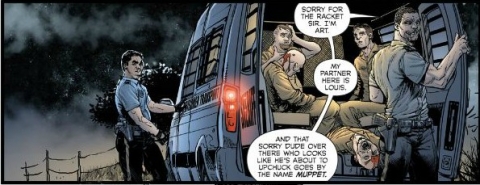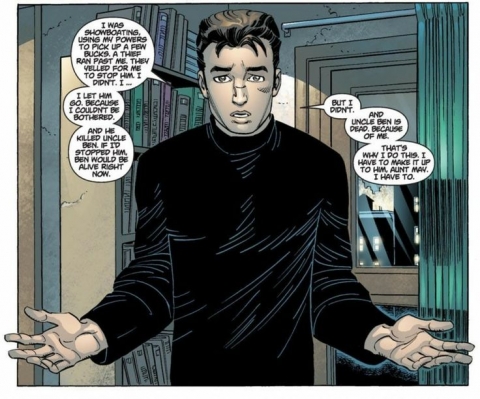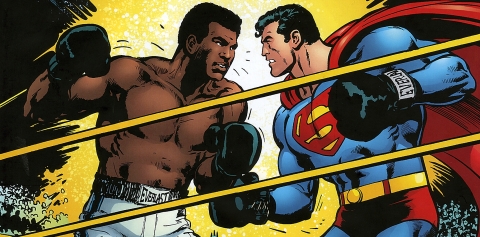52 weeks. 52 different writers. 2 trade paperbacks or hardcovers a week. Each week I’ll take a look at a different writer and read two different collected editions from within that person’s repertoire to help in the examination of their work.
Max Bemis is a fairly recent transplant into the comic world, first finding success in the art form of music. Bemis is the lead singer and songwriter for the rock band “Say Anything”, having toured the world and released multiple records with the band. Back in 2013, Bemis decided to make the jump into comics with today’s book, “Polarity”, from Boom Entertainment. Writing a story about the world’s first bipolar superhero, Bemis drew inspiration from his own life as he too suffers from bipolar disorder.
Polarity
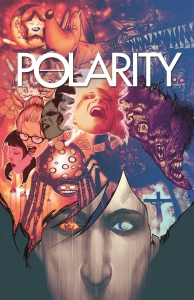 Two years ago Tim Woods walked out in to the middle of a busy Brooklyn street, butt naked and was struck by a passing vehicle during a manic breakdown. That’s when Tim discovered he suffers from bipolar disorder, with the simple joys he had in life becoming muted out by the heavy dosage of drugs he was forced to take daily to suppress his mania. Now, Tim is a fairly average artist living out in Brooklyn, becoming part of (but equally loathing) the subculture he has come to exist within. Surrounded by false hipsters, snobby art critics, and all around awful human beings, Tim questions where the substance he desires in life has gone. He hates his pretentious “girlfriend” and has now come to struggle as his art lacks the unique nature it once had. Deciding to take a stand against his mundane life, Tim stops taking the pills that keep him in check and he begins to do a plethora of different drugs as well as consume copious amounts of alcohol to instil a sense of excitement back into his life. Everything changes for Tim when he realizes that the longer he goes without taking his medication, the more he appears to develop special super human powers. Then he head butts a guy and accidentally makes his head explode. Suffice to say, from there his life gets a little more complicated as he discovers he’s the world’s first bipolar superhero.
Two years ago Tim Woods walked out in to the middle of a busy Brooklyn street, butt naked and was struck by a passing vehicle during a manic breakdown. That’s when Tim discovered he suffers from bipolar disorder, with the simple joys he had in life becoming muted out by the heavy dosage of drugs he was forced to take daily to suppress his mania. Now, Tim is a fairly average artist living out in Brooklyn, becoming part of (but equally loathing) the subculture he has come to exist within. Surrounded by false hipsters, snobby art critics, and all around awful human beings, Tim questions where the substance he desires in life has gone. He hates his pretentious “girlfriend” and has now come to struggle as his art lacks the unique nature it once had. Deciding to take a stand against his mundane life, Tim stops taking the pills that keep him in check and he begins to do a plethora of different drugs as well as consume copious amounts of alcohol to instil a sense of excitement back into his life. Everything changes for Tim when he realizes that the longer he goes without taking his medication, the more he appears to develop special super human powers. Then he head butts a guy and accidentally makes his head explode. Suffice to say, from there his life gets a little more complicated as he discovers he’s the world’s first bipolar superhero.
Max Bemis becomes a fresh new face for comics with his debut miniseries, Polarity. It’s a wild romp, that mashes superheroes, mental health, satire, and Brooklyn hipsters together in a story that is as unconventional as it sounds. To start from the top, Bemis approaches the topic of one’s mental health in a unique way, as he himself suffers from bipolar disorder, much like the main character of Tim Woods. The unique insight he has on the topic shines through, as in most instances someone with a bipolar disorder is usually portrayed as unhinged, manic, and fringing on psychotic. It’s just a natural occurrence for writers nowadays to cast someone with a mental disorder, or someone who’s transgendered, or even racist as a crazed villain because that’s been the archetype these sort of people have been lumped into since writing first developed as an art form. Bemis shucks that trend with the loveable protagonist of Tim though, showcasing a different side of what it means to be bipolar.
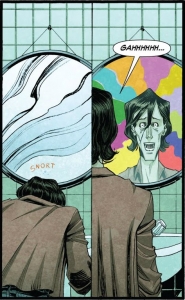 Tim Woods is an incredibly average individual, the type who is ripe for the picking when it comes to crafting a character into a “superhero” like so many origin stories have done before. The bipolar disorder that Tim suffers from is the twist injected by Bemis to give the character a unique spin, differing him from the likes of your Peter Parkers, Bruce Waynes, or Clark Kents. Again, he’s average, white, not that well off, and has a mental disorder, but Bemis spins that as an almost empowering aspect of the character instead of making it a constant and crippling wrinkle in the indestructible superhero facade we’re often fed today. Bemis’ approach to bipolar disorder is the highlight of this comic, largely due to the new ground he paves with this take. Tim isn’t this depressing lump of a human, nor is he a crazed lunatic. He’s astoundingly normal, to the point where if it wasn’t a key element of the story, one might miss the fact that Tim has mental health issues. It would’ve been easy to make this a story about the insane ups and downs of bipolar disorder but Bemis twists everything in just a different way than what you’d expect at every corner of the story. That’s not to say that Bemis still doesn’t address the struggles of living with bipolar disorder, as he most certainly does, it’s just that it’s not this massive, consuming aspect of the story that needs to be detailed on every page of the comic. We get plenty of glimpses at Tim’s highs and lows, as he goes from feeling muted and grayed out by his pills, to essentially being the definition of euphoria when he’s set loose without medication. Seeing the dips and dives in Tim’s personality is interesting as again, it is so different from what you’re strung on to believe about the disorder from just a baseline understanding as a reader. Max Bemis uses the character of Tim to change your view on bipolar disorder when you come into the story and have an entirely different outlook on it when you reach the last page.
Tim Woods is an incredibly average individual, the type who is ripe for the picking when it comes to crafting a character into a “superhero” like so many origin stories have done before. The bipolar disorder that Tim suffers from is the twist injected by Bemis to give the character a unique spin, differing him from the likes of your Peter Parkers, Bruce Waynes, or Clark Kents. Again, he’s average, white, not that well off, and has a mental disorder, but Bemis spins that as an almost empowering aspect of the character instead of making it a constant and crippling wrinkle in the indestructible superhero facade we’re often fed today. Bemis’ approach to bipolar disorder is the highlight of this comic, largely due to the new ground he paves with this take. Tim isn’t this depressing lump of a human, nor is he a crazed lunatic. He’s astoundingly normal, to the point where if it wasn’t a key element of the story, one might miss the fact that Tim has mental health issues. It would’ve been easy to make this a story about the insane ups and downs of bipolar disorder but Bemis twists everything in just a different way than what you’d expect at every corner of the story. That’s not to say that Bemis still doesn’t address the struggles of living with bipolar disorder, as he most certainly does, it’s just that it’s not this massive, consuming aspect of the story that needs to be detailed on every page of the comic. We get plenty of glimpses at Tim’s highs and lows, as he goes from feeling muted and grayed out by his pills, to essentially being the definition of euphoria when he’s set loose without medication. Seeing the dips and dives in Tim’s personality is interesting as again, it is so different from what you’re strung on to believe about the disorder from just a baseline understanding as a reader. Max Bemis uses the character of Tim to change your view on bipolar disorder when you come into the story and have an entirely different outlook on it when you reach the last page.
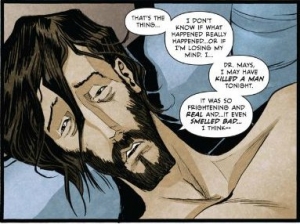 Behind the strong interpretation of bipolar disorder is a whip smart, hilarious story with plenty of satire backed up by a loquacious vocabulary from Max Bemis. Even though Tim does develop “superpowers” he’s far from the standard definition of heroism readers would associate with characters like Captain America or Spider-Man. Instead, the story pokes fun at the idea of giving someone with a mental disorder superpowers, showing readers how easily one could stray from using his powers in a positive manner. Make no mistake that Tim tries to be a “hero”, he just isn’t someone who is really designed to be a hero and that’s what Bemis shows throughout the script. Tim will just as quickly use his powers to break up a drug deal to protect impressionable young hipsters as he would to viciously spank a rude jock for picking on a nerdy teenager. If anything, I’d say that Tim is cast as the human equivalent of your anti-“facebook activist” who actually decides to use his powers to make people more socially aware instead of posting a status for likes or shares. As a result of this, there is a lot of bashing the Brooklyn hipster “movement” in the story, with Bemis taking any chance he can to provide comedic beats through the examination and deconstruction of this “cultural movement”. It starts with casting Tim within this group of twenty-something hipsters before going to great lengths to show why he doesn’t belong within this category yet still kind of does. From there Bemis juggles between the hipster and superhero comedy to strike a chord with readers that they’ll remember, using strongly constructed sentences to really sting points into your brain.
Behind the strong interpretation of bipolar disorder is a whip smart, hilarious story with plenty of satire backed up by a loquacious vocabulary from Max Bemis. Even though Tim does develop “superpowers” he’s far from the standard definition of heroism readers would associate with characters like Captain America or Spider-Man. Instead, the story pokes fun at the idea of giving someone with a mental disorder superpowers, showing readers how easily one could stray from using his powers in a positive manner. Make no mistake that Tim tries to be a “hero”, he just isn’t someone who is really designed to be a hero and that’s what Bemis shows throughout the script. Tim will just as quickly use his powers to break up a drug deal to protect impressionable young hipsters as he would to viciously spank a rude jock for picking on a nerdy teenager. If anything, I’d say that Tim is cast as the human equivalent of your anti-“facebook activist” who actually decides to use his powers to make people more socially aware instead of posting a status for likes or shares. As a result of this, there is a lot of bashing the Brooklyn hipster “movement” in the story, with Bemis taking any chance he can to provide comedic beats through the examination and deconstruction of this “cultural movement”. It starts with casting Tim within this group of twenty-something hipsters before going to great lengths to show why he doesn’t belong within this category yet still kind of does. From there Bemis juggles between the hipster and superhero comedy to strike a chord with readers that they’ll remember, using strongly constructed sentences to really sting points into your brain.
For a clever, witty, and generally enjoyable as Polarity actually is, it still suffers the unfortunate pitfall of a conclusion that feels far too rushed. Everything that occurs through the first three issues feels well paced out and provides you with an enjoyable reading experience. Bemis builds a rich environment for the reader to settle into, gleefully encourage you to want to read more about Tim’s woes with the rising plague of Brooklyn hipsters or the mischief he can cause with his superpowers but then everything comes to a rushed halt with the final fourth issue. I think the problem is that Bemis built so many interesting directions for where the story could go that there simply wasn’t enough time to wrap it all up in a fully acceptable manner. It’s a solid ending but it all feels out-of-place when you consider how intelligent the story had handled itself up to that point. It went out of its way to pave new ground, only to fall back on cliché genre tropes instead of constructing a conclusion that felt original and new for the this wildly imaginative take. It’s a story that acknowledges it’s a superhero story but doesn’t go over the top until the last 25% of the tale that’s being told. Even with all this in mind a story that ends with a decent conclusion doesn’t ruin all the originality pumping through the first three issues of this collection. If anything, with a little more time and polish, Bemis could be a pertinent voice for this generation of comic book readers, especially appealing to the readers who are looking for a bit of direction in this directionless world we’re living in.
Collects: Polarity #1-4.
Best Character: Tim Woods.
Best Line Of Dialogue: “They say not to let your illness define you.” – Tim Woods.
Best Scene/Moment: Tim quickly rips a new one to a room full of hipsters – Issue 2.
Best Issue: Issue 2. The second issue of this collection, to me, perfectly encapsulates everything this series is and should be. You have Tim discovering that he has powers and begins to use them to do whatever he wants. You get some brilliantly comedic scenes, ranging from a sit down between Tim and his psychiatrist, Dr. Mays, to Tim destroying a room full of hipsters and wannabes because he can read their every thought. Bemis gives Tim some breathing room to have some fun and then reels him back in to show the true heart of the character. To top it off, the issue ends with Tim using his powers for the right reason in a perfectly Tim-like way.
Why You Should Read It: Polarity is an honest take on bipolar disorder with a wacky superhero kind of twist. Max Bemis displays plenty of wit and charm in nearly every issue, speaking with the type of voice that can resonate with this generation of readers. There’s humour, drama, heartbreak, and plenty of action as the reader climbs through the weird life of Tim Woods. If that’s not enough, every collected edition comes with a free downloadable EP from Max Bemis so you basically get music and comics in one. How can you say no to that?
Evil Empire Vol 1
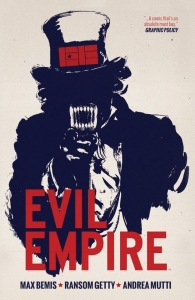 Max Bemis, having emerged on the comic scene in 2013, has found a home with Boom Entertainment. With his first mini-series, Polarity, being published by Boom, Bemis has since then released two other titles under the imprint, as well as having done some work for Marvel Comics and Avatar Press on the side. Bemis’ other two series, Evil Empire and Oh, Killstrike, were well received efforts released in 2014 and 2015 respectively. Still a relative newcomer in the industry, Bemis’ work with Boom Entertainment has quickly made him a must-watch creator for any series he plans to put out over the next few years.
Max Bemis, having emerged on the comic scene in 2013, has found a home with Boom Entertainment. With his first mini-series, Polarity, being published by Boom, Bemis has since then released two other titles under the imprint, as well as having done some work for Marvel Comics and Avatar Press on the side. Bemis’ other two series, Evil Empire and Oh, Killstrike, were well received efforts released in 2014 and 2015 respectively. Still a relative newcomer in the industry, Bemis’ work with Boom Entertainment has quickly made him a must-watch creator for any series he plans to put out over the next few years.
Reese Greenwood is a successful rap artist, producing politically charged hits that resonate with the youth as they take aim at the “system” and expose the glutenous ways of the American Government along with its President. Sam Duggins, a hopeful presidential candidate and massive fan of Reese’s music, pulls some strings to meet the young artist backstage after one of her shows, pouring out his affection to her and revealing how her music really speaks to him even though it’s technically insulting to him. As these two characters begin to forge an unlikely friendship, a call comes in that rocks the United States to its core. President Laramy’s wife has been murdered in cold blood, discovered bleeding out by their daughter in the kitchen of their home. Reese is unexpectedly thrown in front of the tumultuous scandal just as her relationship with Sam Duggins begins to strengthen. These are all the first steps towards a slippery slope that leads to the rise of the Evil Empire twenty-five years down the road, with America becoming a country run right into the ground by its mysterious and benevolent leader.
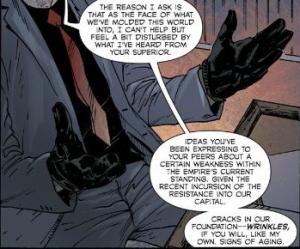 Max Bemis unleashes a captivating political thriller on the world through Evil Empire, with a glimpse into what could happen to America if the power shifted into the wrong hands. It’s a brilliant start to a series that has the stakes to legitimately surprise you, which is equal parts disturbing and oddly relieving in an industry that is known for producing cliffhanger endings every twenty pages or so of an issue. The truth is, in superhero comics, a lot of things are tried and true, being done repeatedly to the point where you get diminishing returns. What’s refreshing about Evil Empire is the fact that it does things that you’ve likely never seen in a political thriller comic, with that genre still remaining a gold mine for storytelling potential. That might be why Evil Empire feels so rich, providing you with a stark glimpse at a reality that might not seem that far off while also giving you something fresh to sink into as Bemis cultivates the world around you.
Max Bemis unleashes a captivating political thriller on the world through Evil Empire, with a glimpse into what could happen to America if the power shifted into the wrong hands. It’s a brilliant start to a series that has the stakes to legitimately surprise you, which is equal parts disturbing and oddly relieving in an industry that is known for producing cliffhanger endings every twenty pages or so of an issue. The truth is, in superhero comics, a lot of things are tried and true, being done repeatedly to the point where you get diminishing returns. What’s refreshing about Evil Empire is the fact that it does things that you’ve likely never seen in a political thriller comic, with that genre still remaining a gold mine for storytelling potential. That might be why Evil Empire feels so rich, providing you with a stark glimpse at a reality that might not seem that far off while also giving you something fresh to sink into as Bemis cultivates the world around you.
The unfortunate truth with this series is that it’s hard to talk about the story beyond doing so at a surface layer as it’s easy enough to spoil all the major twists. The book itself doesn’t necessarily rely on these moments to push the narrative forward, with the underlying ideas all constantly at play, but it’s still nice to be surprised when you read a comic. The comic takes the idea of the “evil empire”, a term coined by President Ronald Regan to describe the Soviet Union decades ago, and twists it in a dark way that reflects the United States as the villain. Each issue begins with a glimpse twenty-five years into the future, seeing the initial street level layer of this Evil Empire. You’ve got “police” who patrol the street and dole out their own punishments as they see fit, effectively fitting into the role of judge, jury, and executioner. It’s dark, brutal, and harrowing to see where Bemis is pushing the story towards, using his present day storytelling to keep you guessing as to what the catalyst for the rise of this Evil Empire is. It all establishes a clean dual plot line where you’re as equally interested in the life of Reese Greenwood in the present as you are with the state of the world in the future. What’s also interesting with this first volume in terms of its storytelling is the fact that Bemis doesn’t necessarily focus on a centralized character in the future plot line. There are hints to who the face of a resistance force may be (and in one instance, a dead giveaway as to who it truly is) but you never get faces put to the leader of the Evil Empire or said resistance. Instead you just largely follow around random members of the Empire police force, seeing their cruel and unusual ways impacting the terrible streets they walk. It’s a storytelling choice that again keeps you guessing and interested, with it being clear that the smoke and mirrors isn’t a viable long-term choice. Sooner or later, the reader will get answers (with some big answers coming your way in issue four) but for this first volume, it’s best to enjoy the ride and keep on guessing as to what might actually be going on instead.
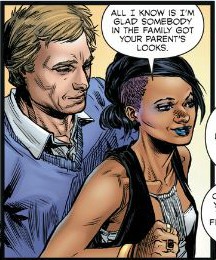 As I stated in the previous paragraph, there is no truly central characters during the future storyline. There is one instance where you get a scene with an implied figure of power but even then their face is covered by shadows. What this means is your main cast all exist in this past plot line leading up to the future, with Bemis providing plenty of interesting characters for you to follow along with. Your clear protagonist is Reese Greenwood, the emotionally charged rapper who uses her music with hopes of pushing for sociopolitical change. Her lyrics are sharp and scathing to those in power, being strong enough to influence more than just the youth with her music. She’s a great character who deals with a few curveballs early on that paints her music in the wrong light, igniting the opposite of the political movement she envisioned. As a result, you get a lot of Reese reacting to the current state of things before really taking it upon herself to be the change she wants to see. It’s great to see Reese grow as the story progresses, shucking off the weak elements of her character in four short issues to become a character you truly enjoy following. This is typically the part where I’d divulge about some of the other players in the plot but, yet again, it’s best for you as a reader to discover who these characters are and formulate your own opinions on them. It’s easy enough to sit here and say Reese goes through one heck of a ride but it’s her interactions with characters during some of these surprising moments earlier on that truly affect her in fascinating ways. In other words: No Spoilers.
As I stated in the previous paragraph, there is no truly central characters during the future storyline. There is one instance where you get a scene with an implied figure of power but even then their face is covered by shadows. What this means is your main cast all exist in this past plot line leading up to the future, with Bemis providing plenty of interesting characters for you to follow along with. Your clear protagonist is Reese Greenwood, the emotionally charged rapper who uses her music with hopes of pushing for sociopolitical change. Her lyrics are sharp and scathing to those in power, being strong enough to influence more than just the youth with her music. She’s a great character who deals with a few curveballs early on that paints her music in the wrong light, igniting the opposite of the political movement she envisioned. As a result, you get a lot of Reese reacting to the current state of things before really taking it upon herself to be the change she wants to see. It’s great to see Reese grow as the story progresses, shucking off the weak elements of her character in four short issues to become a character you truly enjoy following. This is typically the part where I’d divulge about some of the other players in the plot but, yet again, it’s best for you as a reader to discover who these characters are and formulate your own opinions on them. It’s easy enough to sit here and say Reese goes through one heck of a ride but it’s her interactions with characters during some of these surprising moments earlier on that truly affect her in fascinating ways. In other words: No Spoilers.
Nitpick time. There’s only one part of Evil Empire I didn’t absolutely adore and even then it’s a minor part of a larger piece of this story that works so well. It’s the dialogue. Bemis’ dialogue is so on point for 98% of this comic. His characters are articulate, emotive, and, at times, down right chilling with the humanity (or lack there of) they bring to the page. But then there are rare moments where the dialogue just doesn’t hit the right way and comes off corny because it’s stereotypical. This problem largely befalls the character of Reese and her bodyguard, Theo. Bemis throws in a few simple but great scenes that establish they have a platonic, brother/sister like relationship with zero sexual tension. The interactions they have together are usually on point but it’s the interactions with other characters that are quite telling of both of their demeanour and characteristics. There are a few odd scenes where Reese and Theo will speak to each other though and sound like your stereotypical black leads. At no point in the story is it really explicitly stated that these two black characters are from the “hood” or had some exceptionally harsh upbringing that should suggest that they speak like they’re based out of the rough end of the Bronx. Both characters speak somewhat intelligently throughout the duration of this first volume so it was disappointing to see that, with their dialogue being perfect for nearly the whole collection, stereotypes had to creep in during a scene or two to kill some of what Bemis was trying to say with these two characters.
Collects: Evil Empire #1-4.
Best Character: Reese Greenwood.
Best Line Of Dialogue/Caption: “Reese…I can’t thank you enough.” – Kenneth Laramy.
Best Scene/Moment: The reveal at the end of issue 1.
Best Issue: Issue Two. Issue two shows the fallout from the stunning conclusion of the first issue. You watch the world start to erupt into chaos, with Reese caught right in the thick of it. It’s an emotionally powerful issue that moves the reigns ever so slightly. In terms of plot, it’s not like all that much happens. It’s the emotional resonance of this issue that’s important, seeing how the world reacts to the horror that has been unleashed upon it. Perhaps one of the most emotionally powerful moments of the entire series happens at the end of this second issue. There’s no crazy twist, but if you don’t feel a chill crawl up your spine during that last scene then you simply aren’t human.
Why You Should Read It: This is the right kind of political thriller for this generation of readers. It has a message that can speak volumes, some incredibly strong dialogue, plenty of twists you won’t see coming, and it’s just a solid read all around. A central theme to Bemis’ comic work is music and how it makes people think or feel, something he keeps alive with this first volume of Evil Empire. This story is twisted and dark in ways you just won’t expect, but it’s the surprisingly powerful scenes chalked with emotion that will keep you reading until the end.

